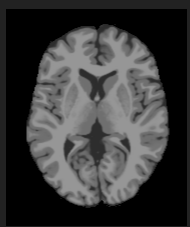现有python的PFCM算法的代码,已经能对示例图进行分割,示例图及其分割结果已附上,请教一下如何对代码进行修改,从而能对附上的大脑mri进行灰质白质脑脊液分割,谢谢

 代包也已经附上,望大佬能给点指点,万分感谢
代包也已经附上,望大佬能给点指点,万分感谢
import numpy as np
def pfcm(data, c, expo=2, max_iter=1000, min_impro=0.005, a=1, b=4, nc=3):
"""
Possiblistic Fuzzy C-Means Clustering Algorithm
Parameters :
- data: Dataset to be clustered, with size M-by-N,
where M is the number of data points
and N is the number of coordinates for each data point. - c : Number of clusters
- expo : exponent for the U matrix (default = 2)
- max_iter : Maximum number of iterations (default = 1000)
- min_impor : Minimum amount of imporvement (default = 0.005)
- a : User-defined constant a (default = 1)
- b : User-defined constant b that should be
greater than a (default = 4) - nc : User-defined constant nc (default = 2)
The clustering process stops when the maximum number of iterations is
reached, or when objective function improvement or the maximum centers
imporvement between two consecutive iterations is less
than the minimum amount specified.
Return values :
- cntr : The clusters centers
- U : The C-Partionned Matrix (used in FCM)
- T : The Typicality Matrix (used in PCM)
- obj_fcn : The objective function for U and T
"""
obj_fcn = np.zeros(shape=(max_iter, 1))
ni = np.zeros(shape=(c, data.shape[0]))
U = initf(c, data.shape[0])
T = initf(c, data.shape[0])
cntr = np.random.uniform(low=np.min(data), high=np.max(data), size=(
c, data.shape[1]))
for i in range(max_iter):
current_cntr = cntr
U, T, cntr, obj_fcn[i], ni = pstepfcm(
data, cntr, U, T, expo, a, b, nc, ni)
if i > 1:
if abs(obj_fcn[i] - obj_fcn[i-1]) < min_impro:
break
elif np.max(abs(cntr - current_cntr)) < min_impro:
break
return cntr, U, T, obj_fcn
def pstepfcm(data, cntr, U, T, expo, a, b, nc, ni):
mf = np.power(U, expo)
tf = np.power(T, nc)
tfo = np.power((1-T), nc)
cntr = (np.dot(a*mf+b*tf, data).T/np.sum(
a*mf+b*tf, axis=1).T).T
dist = pdistfcm(cntr, data)
obj_fcn = np.sum(np.sum(np.power(dist, 2)*(a*mf+b*tf), axis=0)) + np.sum(
ni*np.sum(tfo, axis=0))
ni = mf*np.power(dist, 2)/(np.sum(mf, axis=0))
tmp = np.power(dist, (-2/(nc-1)))
U = tmp/(np.sum(tmp, axis=0))
tmpt = np.power((b/ni)*np.power(dist, 2), (1/(nc-1)))
T = 1/(1+tmpt)
return U, T, cntr, obj_fcn, ni
def initf(c, data_n):
A = np.random.random(size=(c, data_n))
col_sum = np.sum(A, axis=0)
return A/col_sum
def pdistfcm(cntr, data):
out = np.zeros(shape=(cntr.shape[0], data.shape[0]))
for k in range(cntr.shape[0]):
out[k] = np.sqrt(np.sum((np.power(data-cntr[k], 2)).T, axis=0))
return out
def pfcm_predict(data, cntr, expo=2, a=1, b=4, nc=3):
"""
Possiblistic Fuzzy C-Means Clustering Prediction Algorithm
Parameters :
- data: Dataset to be clustered, with size M-by-N,
where M is the number of data points
and N is the number of coordinates for each data point. - cntr : centers of the dataset previoulsy calculated
- expo : exponent for the U matrix (default = 2)
- a : User-defined constant a (default = 1)
- b : User-defined constant b that should be
greater than a (default = 4) - nc : User-defined constant nc (default = 2)
The algortihm predicts which clusters the new dataset belongs to
Return values :
- new_cntr : The new clusters centers
- U : The C-Partionned Matrix (used in FCM)
- T : The Typicality Matrix (used in PCM)
- obj_fcn : The objective function for U and T
"""
dist = pdistfcm(cntr, data)
tmp = np.power(dist, (-2/(nc-1)))
U = tmp/(np.sum(tmp, axis=0))
mf = np.power(U, expo)
ni = mf*np.power(dist, 2)/(np.sum(mf, axis=0))
tmpt = np.power((b/ni)*np.power(dist, 2), (1/(nc-1)))
T = 1/(1+tmpt)
tf = np.power(T, nc)
tfo = np.power((1-T), nc)
new_cntr = (np.dot(a*mf+b*tf, data).T/np.sum(
a*mf+b*tf, axis=1).T).T
obj_fcn = np.sum(np.sum(np.power(dist, 2)*(a*mf+b*tf), axis=0)) + np.sum(
ni*np.sum(tfo, axis=0))
return new_cntr, U, T, obj_fcn
import numpy as np
import matplotlib.image as mpimg
from PFCM import pfcm
import time
def creat_image(labels, centers):
""" color each pixel with the cluster's center color that it belongs to """
img = np.zeros(shape=(labels.shape[0], labels.shape[1], 3))
for i in range(img.shape[0]):
for j in range(img.shape[1]):
img[i, j] = centers[labels[i, j]]
if(img.max() > 1):
img /= 255
mpimg.imsave('Image Result_3.bmp', img) # image result
return img
clusters = 3 # define the number of clusters
img = mpimg.imread('78.bmp') # read the test image
start_time = time.clock() # start calculating the execution time
centers, U, T, obj_fcn = pfcm(
img.reshape(img.shape[0]*img.shape[1], img.shape[2]), clusters) # calling the pfcm function on the image after reshaping it
elapsed_time = time.clock() - start_time # end calculating the execution time
labels = np.argmax(U, axis=0).reshape(img.shape[0], img.shape[1]) # assing each pixel to its closest cluster
creat_image(labels, centers) # creat an image with the assigned clusters
print(f'elapsed time : {round(elapsed_time, 3)} seconds') # printing the execution time
